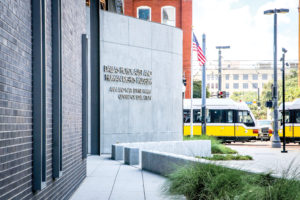Dallas Holocaust and Humans Rights Museum
By William K. Skipworth
With a new name and nearly five times the space, the highly anticipated upgrade to the Dallas Holocaust and Humans Rights Museum will hold its grand opening on Sept. 18. The new museum is located in downtown Dallas at 300 N. Houston St.

Photo courtesy of the Dallas Holocaust and Human Rights Museum
“We think this new museum will be an important part of the cultural fabric of Dallas,” said Mary Pat Higgins, museum president and CEO. “We think it will impact attitudes and change behaviors of our visitors and help them think about their responsibilities to stand up against prejudice and hatred.”
The museum will occupy 55,000 square feet and include a host of new features. The first is the Holocaust Wing where the Holocaust will serve as the focal point. However, in the Human Rights Wing, the museum strives to extend the lessons learned from the Holocaust to other instances of genocide throughout history.
“We thought it was important in this new museum to have a very curated journey that starts with the history of the Holocaust,” Higgins said.
“But then, in the Human Rights Wing, we will teach our visitors about the 10 stages of genocide, which is the process by which genocide occurs and, in that gallery, we will use 10 different historic genocides to help illustrate these stages.” The curators hope visitors walk away having gained insight into genocide and the world around them.
“The goal for that gallery is for visitors to leave having an understanding of the history of 10 different genocides but more importantly to understand the process by which genocide occurs, so they can be aware of what’s happening in the world and when we are potentially at risk of letting another genocide occur,” she added.
The third wing is the Pivot to America Wing, and brings the focus closer to home.
“In the Pivot to America Wing, we look at the evolution of civil and human rights in our own country,” Higgins said.
“The premise is that [the United States] as a country, was founded on these incredible ideals, but the reality has been that those ideals did not apply to all of our citizens. But fortunately, we have had upstanders throughout our country’s history who have worked through the democratic process to bring about change and to make sure those ideals apply to all of our citizens.”
The museum staff hopes that this new direction can help them differentiate themselves and do something new and unique.
“There are not many other museums that we’ve been to that have this thematic design that look at the Holocaust, other genocides and the United States,” Higgins said.
Another one of the key features in this museum will be the Dimensions in Testimony Theater, which is an exhibit that uses technology developed by the USC Shoah Foundation to help visitors have a virtual interaction with holocaust survivors. Visitors speak with and are able to ask questions to a holographic image of a real Holocaust survivor using voice recognition technology. Other features include a Cinemark theater showing mission-relevant films and a real WWII-era German Boxcar.
This upgrade has been decades in the making. The original museum was formed in 1984 by a group of Holocaust survivors living in Dallas.
Max Glauben is one of these survivors. Born in Warsaw, Poland, Glauben was just a child when the Nazis invaded and established the Warsaw Ghetto.
During an uprising, his family hid in an underground shelter but were discovered by the Nazis and sent to Majdanek Extermination Camp. There, his mother, brother and other family members were killed.
His father and he were sent to a labor camp called Budzin. There, his father was murdered, leaving him orphaned at just 13 years old. From there he was sent to a few other camps and later forced on a death march to Dachau, Germany.
During this march, he was liberated by American troops.
In 1947, he immigrated to the United States. Since then, he has served in the U.S. military, met his wife Frieda, with whom he now has three children and seven grandchildren, and lectured at countless schools, churches colleges and events about the Holocaust.
Having experienced the tragedies of the Holocaust firsthand, this museum means a lot to Glauben, who hopes that it will serve to change the minds and hearts of its visitors.
“This museum is a victory as far as I am concerned,” he said. “Because the Germans tried to eliminate me from this world. They were successful with my family, but not with me. And the mere fact that I, personally, was instrumental in this is wonderful.”
Glauben is very proud of the work he and the other survivors put into this museum. But he is particularly excited about the prospects of this exhibit allowing people to learn about the Holocaust well after all of its survivors are gone.
“My grandchildren and their grandchildren and even their grandchildren will be able to speak with a Holocaust survivor.”
